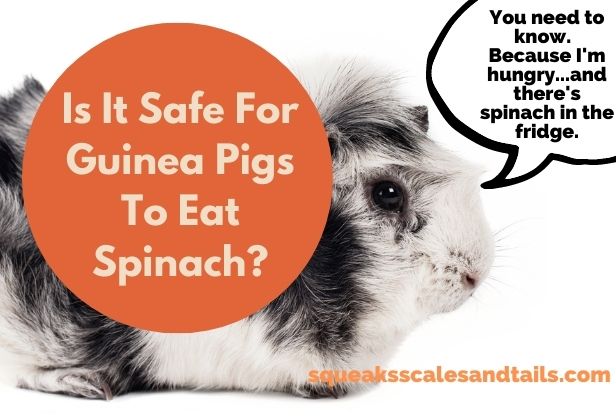Is It Safe For Guinea Pigs To Eat Spinach? (You Need To Know)
In the grocery store, I saw a woman who was buying spinach for her guinea pig. She was talking to another woman. The second woman said that guinea pigs shouldn’t eat it because they would get sick. So, I decided to do some research to figure out if guinea pigs can eat spinach.
The truth: guinea pigs can eat spinach in small amounts – but they can only eat a little bit of it. The recommended serving size is just a few leaves once or twice a week. Although spinach is packed with nutrients, it’s high in calcium and oxalates which can cause health problems if cavies eat too much of it.

So, let’s dive into the benefits of feeding your little friends spinach as well as how to do so safely. That way , you can make an educated decision about how much and when to serve it.
Is Spinach Good For Guinea Pigs?
Actually, spinach is good for guinea pigs. (actually, there’s very few vegetables that are “bad” for piggies).
I say this in spite of the bad wrap that spinach gets for having high amounts of calcium and oxalates.
So, what’s the deal with those minerals? Why should you care?
Too much calcium can lead to bladder stones (potentially deadly) and a high oxalate content helps calcium to bind to other minerals and form the stones.
In other words, if calcium was a manical villain, then oxalates are its evil sidekick.
“Whoa, wait, Aquita. I thought you said there was no such thing as bad vegetables. That whole calcium and oxalate thing sounds way too scary.”
I know, I know. But hear me out.
You could avoid giving your guinea pigs spinach (or any calcium-containing veggie) period.
But, then you’d have another issue. If your piggies don’t get enough calcium in their diet, then they’ll have issues with their bones and teeth.
So, it’s important to find a happy balance of what to feed.
Your best bet is to give guinea pigs this veggie in small, infrequent amounts. That way you can avoid maxing your furry friend out on calcium (bladder stone risk!) while still have them take advantage of all the health benefits spinach has to offer like…
1. Fiber
It’s high in fiber, so if your guinea pig eats enough they will upsize their intake of this nutrient.
Once again, you don’t need to go crazy with the portions – just a few leaves is fine.
Guinea pigs need a high fiber diet for good digestion. It’s important because it helps their good bacteria in their gut process food properly.
The good bacteria helps your piggies breakdown nutrients in their food, and helps your little friends go to the bathroom regularly. (fiber for the win!)
Fiber is critical for guinea pigs to stay regular. Hay is the best, most excellent source of fiber for your piggies.
2.Vitamin C
It’s an excellent source of Vitamin C, which is a great vitamin to feed to guinea pigs – a Vitamin C deficiency can be a serious threat to your cavy’s health.
Vitamin C isn’t naturally produced by guinea pigs. They need to get it from their food that they eat.
If your little friends’ diet doesn’t include enough Vitamin C, then health problems will be right around the corner (waiting to sucker punch your piggies in the throat).
Eventually they’ll get scurvy. Scurvy can lead to blood clotting problems and other health issues concerning the skin, bones, and joints.
Your cavies will probably need about 10 to 50 mg of Vitamin C per day unless a health condition is at hand or if your cavy is pregnant.
Many pellet foods have vitamin C in them, but it’s still best if you give your piggie their daily Vitamin C intake from fresh, raw fruits or veggies.
Like other vegetables, spinach is rich in vitamin C.
In the United States, you can get 28.1 milligrams of vitamin C from each 100 grams of spinach. Guinea pigs shouldn’t eat 100g of spinach a day, but a few leaves will certainly help them get their vitamin C needs met.

If you want lots of Vitamin C, but without the calcium and oxalates, try giving your piggies bell pepper. It actually has more Vitamin C than an orange!
3.Low Sugar
Fruits and vegetables are good to eat, but some have a lot of sugar. Too much sugar can make your guinea pig get overweight and have diabetes.
Spinach is an ideal treat since it has la low sugar content and high fiber. It reduces the risk of your cavies gaining weight and getting diabetes.
Diabetes isn’t common among guinea pigs, but when pet parents give them food that has a lot of sugar, the chance for diabetes goes way, way up.
Some common symptoms of diabetes in guinea pigs are trouble urinating, thirstiness, cataracts and fertility problems.

Guinea pigs are also likely to get diabetes when they eat too much sugar. They can eat spinach because it has low sugar and high fiber, so the guinea pig won’t get diabetes or gain weight.
Is Eating It Risky For Guinea Pigs?
The health benefits of spinach are promising for guinea pigs. But, there are a few drawbacks.
Most of the healthiest vegetables for guinea pigs have some risk. (yep, those calcium and oxalates are not your piggie’s friends!)
That’s the case with spinach.
But, there’s no need to banish it from your guinea pigs lives forever. This just means you’ll need to serve it to them responsibly.
Overfeeding your little friends causes the health issues.
Health issues that we’re gonna cover now by starting with…
The Effects Of Lots Oxalates Calcium & Phosphorus (a.ka. The Triple Threat)
Oxalates and calcium are natural organic compounds that can be found in leafy green vegetables and other plants.
Let me tell you a sad, little story (with an easily avoidable ending) about it:
- You feed way too much spinach to their piggies.
- Your piggie eats it – which is high in oxalates and phosphorus that bind with the high amount of calcium.
- The calcium (because there’s too much for your piggie to absorb) hangs out in the kidneys (or bladder) and starts binding with other minerals – making calcium oxalate crystals.
These crystals could cause the following conditions:
1. Bladder Stones
Cavies can get bladder stones by eating too many oxalates.
Bladder stones are common in guinea pigs.
There’s one main for this: they’re given too many foods high levels of calcium and oxalates by well-meaning pet parents.
If your cavy is experiencing the following symptoms, perhaps it’s time to see the vet and verify if it is caused by bladder stones.
- Weakness
- Blood in urine
- Painful urination
- Frequent urination in small amounts
2. Kidney Failure
Your cavy might get kidney failure if they eat too much of a plant that has oxalate in it. This is called oxalic acid poisoning.
(Don’t worry. This won’t happen if your piggie eats spinach in appropriate amounts. This is the result of a poor diet for your fur babies over a long period of time.)
Kidney stones are made of calcium oxalate crystals. Those crystals can form slowly in the kidneys, and it can also lead to bladder stones.
(Yes, they’re two different things; I didn’t know at first either; I literally had to look it up).
The more calcium oxalate crystals that form, the worse off your guinea pig’s kidneys will be.
Eventually this can lead to kidney failure. This can be fatal to your little friends.
Remember that guinea pigs should only have 1 cup of fresh vegetables (and maybe a few fruits) each day. Most of that cup should be green, leafy vegetables.
Nutritional Breakdown Of Spinach
The USDA has listed down the nutritional composition of raw spinach. Here are the essential nutrients your guinea pig can gain from every 100 grams of spinach.
- Water – 91.4 g
- Protein – 2.86 g
- Fats – 0.39 g
- Dietary Fiber – 2.2 g
- Calcium – 99 mg
- Iron – 2.71 mg
- Magnesium – 79 mg
- Phosphorus – 49 mg
- Potassium – 558 mg
- Zinc – 0.53 mg
- Copper – 0.13 mg
- Sodium – 79 mg
- Vitamin B6 – 0.195 mg
- Vitamin C – 28.1 mg

If you want some tips on how to build a better relationship with your guinea pigs or how they relate to each other, check out these posts: 15 Wonderful Ways To Entertain Your Guinea Pig (Right Now) and 10 Shocking Mistakes That Make Your Guinea Pig Hate You
Do Guinea Pigs Like Spinach?
Guinea pigs love to eat leafy green vegetables. So, there’s no doubt that under normal circumstances, most guinea pigs will like spinach.
But, some piggies are a little picky and yours may not.
Just offer them some and see how they take to it. And don’t be afraid to offer it more than once.
Sometimes cavies need to be introduced to a new food more than once before they really start to like it.
Raw spinach has a slightly sweet taste with springy or crisp consistency.
It’s not just delicious but the texture also allows your cavies to work their teeth on it – which helps them grind down their can’t-stop-growing teeth from getting too long.
Can Guinea Pigs Eat Spinach Every Day?
Don’t feed spinach to your guinea pigs every day. If you do, you’re almost guaranteed to have piggies that end up sick.
Despite the many nutrients it has, it also causes bladder stones or sludge. This is a common condition among guinea pigs. (Darn calcium! Darn oxalates!)
So, here are a few tips to feed your furry friend spinach safely:
- Offer itonce or twice a week (or every two weeks) for your guinea pig to enjoy without worrying too much – just a few leaves.
- Don’t feed your little friends this particular veggies on consecutive days. Instead, provide it on alternate days – yes to it on day, no to it the next.
- It should never be your cavies’ main leady veggie.
- If you’re feeding your piggies spinach one week, don’t feed your piggies too many other high-calcium vegetables. If you feed your piggies a small quantity of it one week then don’t offer any arugula, dill, kale or parsley (all high-calcium) at all that week.
- Alternate spinach with low-calcium vegetables like endive, bell peppers, alfalfa sprouts, or escarole – you don’t want to max out on the guinea pigs’ calcium and oxalate intake.
That way your piggies can enjoy the benefits of spinach (or any other high calcium veggies for that matter). And you don’t have to worry about building up a ton of calcium in your guinea pig. (can I get a hip hip hooray!…or at least a yay?)
They can. Just don’t feed too much and you’ll be fine!

Don’t offer spinach to guinea pigs that have a sensitivity to bladder stones or sludge. It’s better to keep your guinea pig away from it altogether if she has those kind of health issues.
How Much Spinach Can I Give My Guinea Pig? And How Often?
A small leaf or a couple of baby leaves are enough to feed your guinea pig. Giving them more than that can cause potential harm.
Also, you can let your guinea pig eat spinach one to two times a week. Don’t give your cavy spinach two days in a row.
Eating too much can lead to health problems for your fur babies. Eat the suggested amount and number of times.
Should I Feed Spinach To My Guinea Pig?
Well, you can certainly feed your spinach to your cavy safely.
Just feed your little friends spinach in moderation, otherwise, you’ll be gambling your little piggy’s health.
Look at your piggie’s individual circumstances.
Pregnant and cavy babies (6 months or younger) typically need more calcium than your average, healthy adult guinea pig – so they likely won’t have health problems from eating a small amount of it more than once or twice a week.
But, if your cavy has kidney or bladder stone, avoid giving spinach altogether. It’ll make the problem worse.
Talk to your vet if you have doubts about the effects of spinach on your guinea pig’s body.
Examples of Veggies With More And Less Calcium Than Spinach
While spinach contains adequate calcium, the presence of oxalates makes it pretty hard for your cavy’s body to absorb it.
Cavies need some calcium in their bodies to stay healthy.
If they don’t have enough, their teeth will be unhealthy and they could have bone problems. (yeah, not fun for your piggies)
If your cavy needs more calcium, consider the following veggies:
- Broccoli
- Beet greens
- Collard greens
- Kale
- Mustard greens
- Parsley
- Swiss chard
On the other hand, here are some veggies that contain less calcium than spinach.
How To Serve and Store Spinach For Your Guinea Pigs
The line between the good and the bad effects of feeding your guinea pig spinach is quite thin.
What you need to know as a parent is that your baby’s diet mainly depends on the size of the serving and how often they eat it. So, here are some tips for feeding spinach to your cavies:
- Buy organic when you can. It’s healthier for guinea pigs
- Check spinach leaves for insect damage. Make sure that it’s not dirty or has any unusual colors. It shouldn’t have any rotting areas.
- Clean the leaves thoroughly to get rid of any pesticide residue.
- If you’re serving baby spinach, you can toss few (2 or 3) leaves into their food bowl. If you’re serving whole spinach, chop it into a smaller pieces before you feed it to you fur babies.
If you have plenty of spinach leaves left, refrigerate the rest for other uses.
But before you put the leaves away, make sure they are dry. Moisture will damage and spoil the spinach leaves faster.
Can Guinea Pigs Eat Baby Spinach?
Guinea pigs can eat baby spinach. They’re smaller than regular spinach which makes them easier to serve.Baby spinach also contains the same nutrients as regular spinach, so your piggies aren’t missing out on anything.
Can Guinea Pigs Eat Canned, Frozen, Or Cooked Spinach?
The most ideal spinach to feed your cavy is fresh or raw. However, in the absence of fresh spinach, you may turn your attention to similar alternatives.
But, it is important to know that just because the food product has the word spinach in it, it doesn’t mean that it is as healthy as raw spinach.
1.Cooked
Never, ever serve cooked food to your piggies.
What some people don’t realize is that when you cook food, the nutrients are changed, and can even be destroyed.
Piggies should only eat fresh foods because of this reason.
Plus, their digestive systems aren’t made to handle cooked food well at all.
Fresh is always best.
2. Canned
Don’t feed your guinea pigs canned spinach (actually all canned foods should be avoided) for two big reasons:
- the preservatives (not good for your furry friends)
- the lack of nutrients: canned food (after it’s gone through the canning process) typically doesn’t retain as many of the nutrients that are in the raw fresh form
3. Frozen
Guinea pigs can’t eat frozen spinach. Frozen spinach (heck, any frozen food) are an unusual addition to the guinea pigs diet.
Eating this cold food may cause their tummy to get a little bit upset. This is because frozen food isn’t a part of their natural diet in the wild.
Their digestive systems are so sensitive that eating anything that’s too cold can make them sick.
“What if we let the spinach melt a little before giving it to the piggies?”
Uhh, no. Still don’t do it.
If you eat defrosted spinach, the leafy green tastes terrible. (It’s a wet mess of goop that doesn’t look very appealing).
Raw foods are always your best bet.

Avoid serving cooked, canned, or frozen (yes, even if it’s defrosted) spinach to your guinea pigs.
What Other Leafy Veggies Can My Pet Eat? (Alternatives To Spinach)
If you feel like spinach is not the leafy green vegetable, you want for your guinea pig (or if your piggies just don’t like them), consider other similar alternatives.
(Actually, even if spinach is your cavies’ favorite treat, you should still consider adding in a couple of other guinea pig-safe greens to their diet!)
The variety of vegetables will make sure that your fur babies get all the different nutrients that they need.
Here are other leafy veggies you can choose from:
- Mustard Greens
- Arugula
- Bok Choy
- Cabbage
- Cilantro
- Collard greens
- Dandelion leaves
- Kale
- Lettuces
- Parsley
- Swiss chard
These leafy veggies also contain plenty of nutrients to keep your piggies happy and healthy (which is what you really want)
No matter which, spinach alternative you choose, just remember that a balanced diet is still best for your cavy.
This means that you should not feed your guinea pig excessive amounts of any of these leafy veggies. And make sure that you don’t feed them more often than you should

Guinea pigs can eat many different types of leafy veggies! There are plenty of guinea pig-safe greens that guinea pigs can eat for the variety of nutrients they need to stay healthy and happy. Just don’t overfeed them and avoid giving them too often.
Some Food Guinea Pigs Should Avoid
While we generally perceive fruits and veggies as safe and healthy, it’s not exactly true with guinea pigs.
There are organic foods that are exceptional for your cavy’s health and there are those that are simply dangerous.
They could either make your piggies sick or cause choking.
Here are some examples of foods that guinea pigs should avoid:
- Nuts
- Seeds
- Grains
- Cereals
- Dried beans
- Lentils
- Corn
- Peas
- Lilies
- Avocado
- Onions
- Garlic
- Mushrooms
- Rhubarb
- Hot peppers
Conclusion: Guinea Pigs And Spinach
Now that you’ve read through this article, you know that there’s no need to be nervous about adding spinach to your piggie’s diet.
Make sure you give your guinea pig the right amount of spinach – only feed it as an occasional treat. If they eat too much, it can make them sick.
Some good things are in spinach, but it also has harmful parts. Which is why it’s mission critical for you to feed it to your fur babies in the appropriate amounts.
Stick to the recommended serving size of one or two chopped leaves given once or twice a week (and make sure your piggies have a balanced diet) and you’ll be good-to-go.
Good luck!






